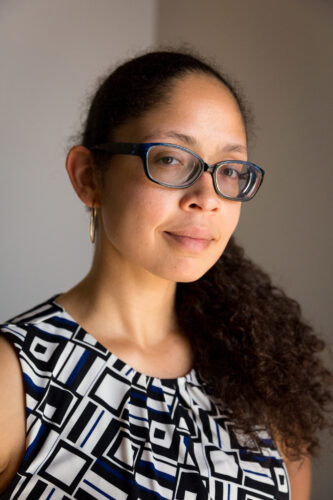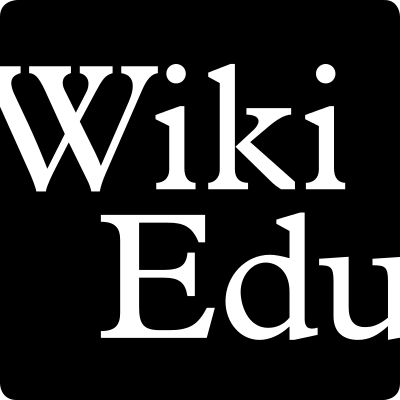Charisse L’Pree is an associate professor of communications at Syracuse University. She incorporated a Wikipedia assignment into her course for the first time last term.
I teach media effects to professional public communication students. I used the Wikipedia assignment as a final collaborative project in a 300 level class that meets the diversity requirement for Newhouse undergraduate students across majors including journalism, advertising, public relations, television, radio, and film, music business, and more.
This course is situated at the intersection of American history, psychology, and the media industry to help contextualize how media impacts society, specifically with respect to perpetuating long standing disparities. I was excited to incorporate the Wikipedia assignment into this course to demonstrate how the absence of available information (and perspectives) is just as important as the information that is available. Especially in the wake of the 20th century where an exponential increase in content and accessibility can cause people to believe that what is not recorded is not valuable (Corsbie-Massay, 2021, p54).

Project Process
Students began with a personal exploration of how they use Wikipedia and what they have been told about the quality of information on Wikipedia. Almost everyone reported relying on Wikipedia for context at some point, even though past teachers and instructors repeatedly warned them that the information on Wikipedia was not reliable. However, only a handful (<10%) had ever attempted to edit a Wikipedia page.
We then read “Interrupting epistemicide: A practical framework for naming, identifying, and ending epistemic injustice in the information professions” from Patin et al. (2021) and discussed how the absence of information impacted ongoing institutions and systemic disparities. We also had a guest lecture from the University Librarian affiliated with Newhouse that described the resources available through the library and the importance of discerning, digitizing, and distributing information.
I then provided students with a list of locally relevant topics that did not have Wikipedia pages, or whose pages were categorized as “Stub.” This list was wide ranging and included neighborhoods (33%) and local non profits (26%), as well as gay bars, historical markers, and even the jail located just 1 mile away from our classroom. Students indicated their preference and were paired accordingly. At the end of the semester, each pair recorded and posted a 4m presentation to the class webpage answering the following questions…
- What did you find most interesting about writing a Wikipedia Article?
- What did you find most difficult about writing a Wikipedia Article?
- How did the class content connect to this experience?
- What should readers of your article be sensitized to?
- How do you hope future Wikipedians will edit/add to your article?
What I Observed: Generational differences in working “under the hood”
The students really struggled with the interface of Wikipedia, which was interesting for a generation that has been labeled “tech savvy.” The project reminded them that there is a difference between content and technology: Creating content has become so user-friendly, creators do not need a proper understanding of how things work “under the hood.” I don’t know if any students attended the office hours held by Wiki Education (then again, few students come to my own office hours) and although they completed the exercises associated with the project (for which they received credit), they moved quickly through the assignments and still expressed confusion. In the end almost all of the pairs made it work, but those who waited until the last minute really suffered.
Furthermore, only a handful of students sought information that was not already digitized (e.g., newspapers, library resources), despite extensive discussion regarding the digital divide and information injustice. I thought that public communications students would be excited to publicly communicate the information from the not-so-distant past, but several students stated in their reflections that they couldn’t find additional information online and gave up. This surprised me as I thought I had made it clear that most sources existed before the internet and if something is not online then that means it simply hasn’t yet been found. In my opinion, the students did not yet recognize that digitizing the past is a desperate social need.
What My Students Observed: Wikipedia is not a source, it is a resource.
Many described the strange feeling of being on the other side of the Wikipedia interface but by the end of the semester, they reported a greater understanding of how Wikipedia is made. This helped improve their ability to use Wikipedia as a resource, including contributing and editing. Many journalism students also expressed that the objective lens required by Wikipedia did not align with how they were taught to write; they were taught to share objective information through a subjective lens (i.e., storytelling) to engage the audience. The project also revealed the collective backend labor involved in every Wikipedia contribution. Together, these observations help disabuse the students of talking points they heard prior to the project (i.e., “You can’t trust Wikipedia”).
Students ultimately connected this exercise to recognizing epistemic injustice as well as the role of Wikipedia in working to overcome social disparities. They saw ways to contribute to the public discourse and elevate public awareness through Wikipedia as a popular independent information resource. We talked about hyperlinking local entities (e.g., non-profits, neighborhoods) to other state or national pages with more web traffic, as well as the importance of information evolution (e.g., information was not just “outdated,” it needed to be “updated,” and this ongoing gap always provided new stories and angles to pursue). Overall, they responded positively to the exercise as it gave them insight into a staple of their information ecosystem (Introne, et al., 2024).
In Conclusion
I would definitely do this project again. It was an honor to digitize and distribute information about local entities. Having said that, the learning curve for the students was sharp as was the learning curve for me as the instructor. In the future, I would probably dedicate a lecture to going through some of the exercises as a group to ensure students do not rush through this important material and that everyone was on the same page (literally!). But at the end of the semester, I really felt like we were helping advance a cause associated with a popular quote from author and activist Grace Lee Boggs: “History is not the past. It is the stories we tell about the past” (Boggs & Kurashige, 2012, p. 79). Therefore by synthesizing and digitizing stories from the past, we are literally doing the work of writing history.
Interested in incorporating a Wikipedia assignment into your course? Visit teach.wikiedu.org to learn more about the free resources, digital tools, and staff support that Wiki Education offers to postsecondary instructors in the United States and Canada.
